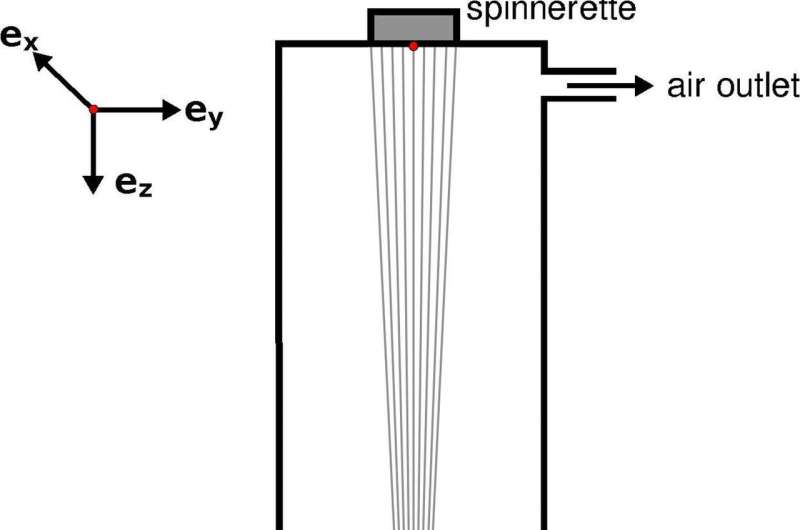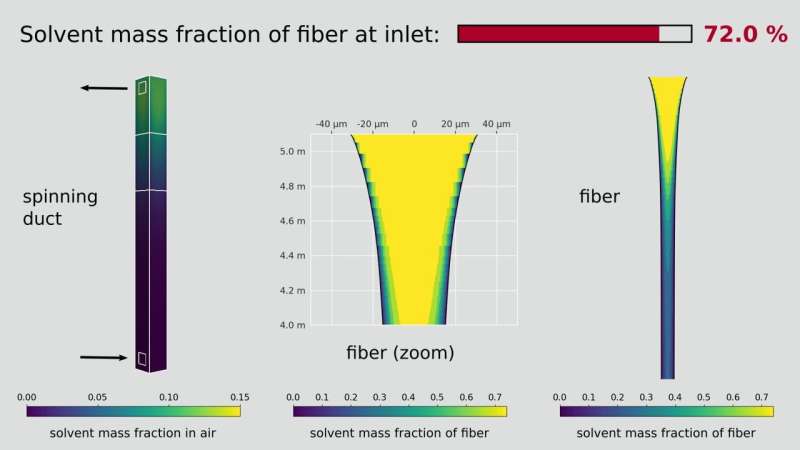Simulating and optimizing industrial spinning processes

Spinning polymer filaments, for example for personal care articles, is highly complex: simulating the processes involved is too much for currently available computing power to handle. Fraunhofer researchers have successfully applied new approaches to simplify the calculations necessary for simulation. Now for the first time complete spinning processes can be simulated, providing a better understanding of the processes and greatly simplifying their optimization.
Heat-resistant materials for aircraft turbines, personal care articles and clothing are often made with polymer fibers. These fibers consist of a large number of filaments with a diameter in the order of a few micrometers which are intertwined with one another. The filaments are produced using spinning processes that in a way resemble a noodle press used to make spaghetti. First the polymer is mixed with a solvent to make it viscous, i.e. more fluid, so that it can be pressed through a spinning plate, a kind of sieve containing thousands of micro-holes. The resulting ultra-fine filaments then drop through a duct several meters long. While falling they are blown dry with air or gas, thus removing the solvent. The individual filaments are wound onto large spools at the bottom of the duct. Until now it has not been possible to simulate such spinning processes as a whole: they are simply too complex, requiring the simulation of billions of infinitesimally tiny spatial cells. In the past companies seeking to optimize spinning processes had to procure a pilot system costing several hundred thousand euros and then run tests for each of the countless parameters.
Precise simulation of the complete process
Now for the first time researchers at the Fraunhofer Institute for Industrial Mathematics ITWM in Kaiserslautern have developed a tool capable of simulating spinning processes involving thousands of filaments. "Our simulation reproduces the solvent concentration in each individual filament, as well as the mutual interactions of all filaments with the gas flow," says Dr. Walter Arne, research associate at Fraunhofer ITWM. "The resulting simulation represents not only the complete aerodynamic situation of the system, for example velocity and temperature profiles and solvent distribution, it also generates the relevant state variables along the filaments, for example temperature." This means that manufacturing companies can quickly and easily get to the bottom of difficulties in the production process, can increase their understanding of the decisive parameters and can scale up new manufacturing processes with relative ease. An example: When turbulence effects in the duct are so strong that the individual filaments repeatedly come into contact and stick together, Dr. Arne and his colleagues can use the simulation to investigate the gas flow and optimize it with new component parts in order to eliminate the problem. This reduces production waste and increases filament quality.

Objective achieved using various simplifications
A variety of new functions have made it possible for the Fraunhofer ITWM research team to keep the complexity of the simulation at manageable levels. "We begin with the gas flow in the duct as it would be without the presence of the filaments. We don't consider the filaments themselves as three-dimensional objects, but rather as one-dimensional curves," Arne explains. However, not only do the filaments "dance" in the gas flow, they also impact the flow while doing so. Shooting downward at a speed of up to ten meters per second, the filaments also accelerate the surrounding air, much the same way as a speeding train moves the air around it. The researchers make several consecutive computational steps in order to cover this mutual interaction in the simulation. In the first step they begin with the flow without the filaments. Based on this flow situation, they calculate the filament parameters and feed this data into the calculations on the gas flow. The simulation then performs iterations of these calculations until a balanced state is achieved and the values no longer change.
However, this simulation still doesn't produce information on one vital aspect of the spinning process, namely how the solvent is distributed in the filaments. This is important because the outer surface of the filaments exposed to the air flow dries very quickly, while the solvent remains inside the filaments for quite some time. But the filaments are regarded as if they were one-dimensional, as if they had no width and thus no cross-section. A three-dimensional representation would be beyond the limits of what is feasible. Here too the scientists have something in their "bag of tricks". They stick to the one-dimensional representation, but they add an additional component, the radial distribution of the solvent. How much solvent is there inside the filament, and how much on its outer surface?
In essence the simulation is ready to go into operation: the researchers have already used it to optimize various spinning processes for their customers. Michael Rothmann, head of development at BJS Ceramics, is thrilled: "Our current partnership made it possible for the first time to simulate the complete spinning process. This gave us insights into subareas of the process which had been inaccessible in the past. These results will in the future make it possible for us to conduct more focused process optimization and thus shorten our development cycles." The Fraunhofer researchers plan to further develop the simulation tool in an additional project so that manufacturing companies can run the software themselves on their own premises. If all goes according to plan, licenses for the software are expected to be available in approximately three years.
Provided by Fraunhofer-Gesellschaft





















